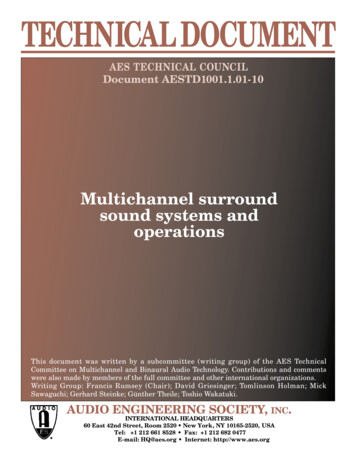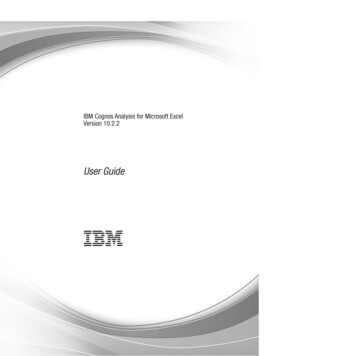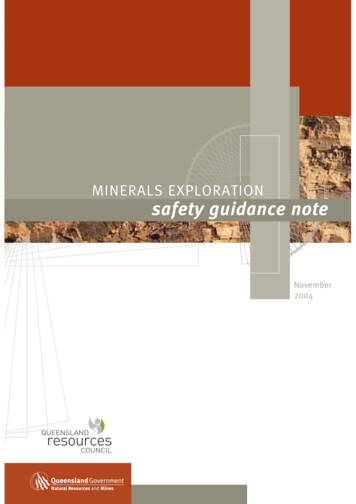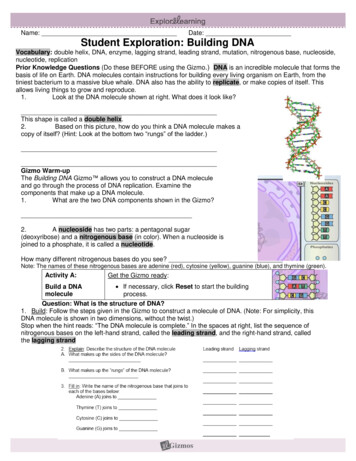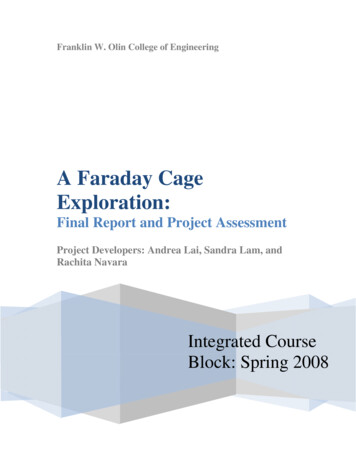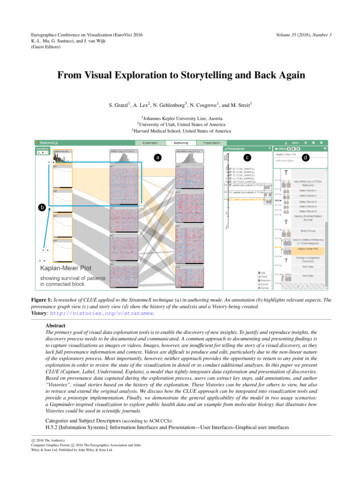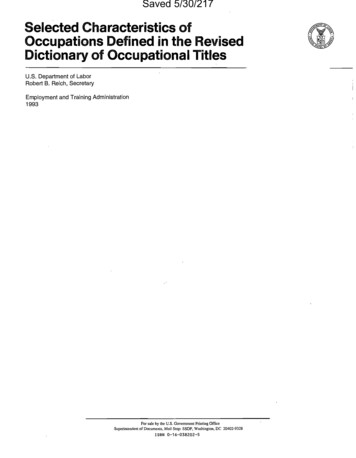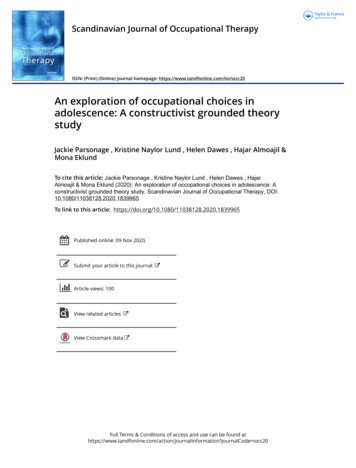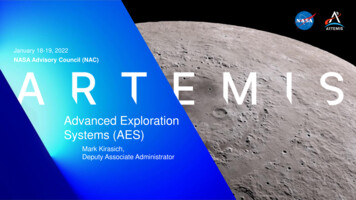
Transcription
January 18-19, 2022NASA Advisory Council (NAC)Advanced ExplorationSystems (AES)Mark Kirasich,Deputy Associate Administrator
2Advanced Exploration Systems (AES) MissionCreate a sustainable lunar and beyond human space exploration program HLS, Gateway, Exploration Suits, Lunar Terrain Vehicle and future Surface Mobility System Programs Plan and execute Artemis III Missions Develop advanced technology for long duration exploration missions
Human Landing System (HLS)
Human Landing System (HLS) Program Office The HLS Program Office isestablished at MSFC Business rhythm andgovernance established Control boards, monthlyelement reviews,program quarterlyreviews, risk boards Contract for the first crewedlanding (Appendix H, OptionA) in place Procurement planning forrecurring landing services(Lunar ExplorationTransportation Services)under way4
Initial Human Landing SystemAppendix H Option A: Uncrewed Demo and firstCrewed LandingAPR 2021SpaceX selected for Option A (DDT&E andfirst crewed demonstration mission)JULY 2021Option A Contract AwardNOV 2021US Court of Federal Claims upholdsSpaceX Selection, contract resumedTBD 2022 First five SpaceX milestones complete;very strong data packages/reviews Milestone schedule updated in thecontract Updated Integrated Master Schedulereceived and under evaluation Site visits to Boca Chica and Hawthorneshowed significant Starship progressUpcoming Milestone: Orbital Flight TestImage Credit: SpaceXClose-up of Apollo Astronaut's Footprint in Lunar SoilImage Credit: SpaceX
SpaceX HLS ProgressSN11B4 and S20 stacked Aug 2021S20 static fires Oct – Nov 2021
Additional HLS Procurement ActionsAppendix N Prepares industry for the transportation services competition (also called a “bridge”) Initial awards to five companies: Blue Origin, Dynetics, Lockheed Martin, Northrup Grumman, and SpaceX CLIN 1 completed Nov 2021: Industry assessment of draft sustaining lander requirements Initially awarded CLIN 2 Risk Reduction work under way (initial awards based upon available funding) Additional work (CLINs 2, 3 and 4) may be awarded based upon available fundingHLS Lunar Exploration Transportation Services (LETS) Develop and certify at least one affordable lunar landing solutions for sustained transportation services Two Request for Information (RFI) cycles completed to date in addition to App N DDT&E through Certification Includes an uncrewed test of the human landing system Contractor/Provider responsible for obtaining the launch vehicle CLINS (severable) for Large Cargo missions; (not competing with GLS or CLPS) Services Schedule: Recurring missions beginning 2028 IDIQ task orders for NASA determined mission assignments (includes flight readiness, post-flight review, etc.) Draft RFP to be available Spring, 2022
Gateway
Gateway Program Office The Gateway Program Office wasestablished at JSC in Feb 2019 International Partner MOUs withESA, CSA, and JAXA signed inDec 2020 - defining agency roleswith contributions and benefits Business rhythm and governanceestablished Control boards, monthlyelement reviews, programquarterly reviews, risk boardsRelationships/Integration withInternational Partners, Primecontractors, Orion, and HLSwell defined All early element contracts inplace (less airlock)9
Gateway Integrated SpacecraftCo-manifested PPE/HALO Launch VehicleGateway ExternalRobotic System (GERS)Logistics ModuleHTV-XGResupply(proposed)Power and PropulsionElement (PPE)Airlock(provider TBD)ESPRIT-RefuelerInternational Habitat(I-HAB)Habitation andLogistics Outpost(HALO)Orion SpacecraftHuman Landing System (HLS)(govt. reference concept shown)EuropeanService Module
Gateway Program Major AccomplishmentsCalendar Year 2021FEBPPE/HALO Launch Vehicle contract awardFEBHALO primary structure assembly initiated in ItalyMARGateway Program SDR Delta Sync ReviewAPRGateway Program Key Decision Point 0APR6 kW solar electric propulsion (SEP) subsystem test byPPE, Maxar, BusekMAYHALO Preliminary Design Review (PDR) Close-outJUNEJULGateway Integrated Analysis Cycle (IAC) #7 kicked offNorthrop Grumman awarded HALO contract(fixed price)AUGLive ISS/HALO Q&A eventNOVInternational Habitat (I-HAB) PDR Part 2 Close-outDECGateway PPE Maxar PDR Part 2
Gateway Program Upcoming Major EventsCalendar Year 2022 Block update to Maxar requirement set and PPE Base Completion Review Gateway Program Preliminary Design Review (PDR)-informed Sync Review and Key Decision Point (KDP) 1 Gateway External Robotics System (GERS) System Requirements Review (SRR) PPE Maxar Systems and Integrated CDR HALO Systems and Integrated CDR Falcon Heavy Extended Fairing CDR Ship and delivery of the HALO habitable element, manufactured by Thales Alenia Space Italia (TASI) Ship refueling breadboard test rig to ESA for ESPRIT testing Continue GLS special studies in advance of first mission ATP Initiation of 12 GFE items required for initial capability and delivery of NDS passives/S-Band radios for HALO Continued build-out of Lab facilities (power, com, avionics/software) Design Analyses Cycle 8 kickoff Focused area on ICD development and detailed verification objectives across the program
Spacesuits andHuman Surface Mobility Systems
Exploration Extravehicular Activity (xEVA) Status xEVA Services (xEVAS) procurement to provide suits for ISS, Gateway and the lunarsurface Proposals received on Dec 14th, 2021 Targeting contract award April 2022 Continued strong government-based risk reduction work Initiated exploration Extravehicular Mobility Unit (xEMU) design verification testing (DVT) of thepressure garment subsystem (PGS) and portable life support subsystem (PLSS)xEMU DVT HelmetLight Testing Primary and auxiliary Thermal Control Loop testingHelmet light and camera assembly vibration testingAntenna pattern testingPGS partial gravity mobility evaluations at Active Response Gravity Off-load System facility (ARGOS) Successfully completed first human-in-the-loop test series in upgraded 20ft Chamber test facility Successfully completed fifth of six planned on-orbit simulated EVA series with the SpacesuitEvaporation Rejection Flight Experiment (SERFE) following a planned 210d dwell period Test data and reports will be added to EVA Technical Library to reduce risk for future xEVASpartner(s)xEMU Antenna Testing
Exploration Extravehicular Mobility Unit (xEMU)Design Verification Testing (DVT) andProject Technical Review (PTR) xEMU DVT unit is an extremely high-fidelity EDU xEMU DVT’s purpose is to reduce the risk of failure duringQual, post CDR, late in the development cycle DVT testing will assess majority of requirements by evaluatingadequacy of component and assembly level performance DVT results anchor analytical models DVT validates alternate components acceptability whereparallel suppliers have been developed xEMU PTR will be a tailored internal review of CDRlevel design products Among several outcomes, PTR allows NASA to clearly rankthe fidelity/maturity of the xEMU design products available attime of xEMU closeout, prior to transition to xEVAS To avoid unnecessary overhead, xEMU PTR will not be aformal CDR Focus is on technical content, not processxPLSS DVT Assembly as of May ‘21xPGS DVT Assembly as of May ‘21Vent Loop Assembly underwayPressure Checks underway
Human Surface Mobility (HSM) Status Released a second Lunar Terrain Vehicle (LTV) Request for Information in September 2021 Received 21 responses containing feedback on approaches to surviving the extendedlunar night, supporting 10 years of operation, delivery service preference, and interest inproviding LTV as a commercial service. Responses are feeding updates to the Survive the Night assessment and informing LTVprocurement strategy. Completed initial draft of requirements and initial standards tailoring to support upcoming LTVMission Concept Review (MCR), including those for LTV system and interfaces to xEVA, HLS,communication systems, and payloads. Investigated strategies for changes to LTV Reference Design power and thermal subsystemsfor surviving longer periods of lunar night Held a three-day TIM with JAXA to discuss Pressurized Rover high-level system requirementsand concepts of operation, as a part of the ongoing feasibility study Initiated an AES cross-program analysis to assess impacts of incorporating a suitportrequirement for sustained lunar surface operations. A final decision on the requirement is expected in early spring and programmaticdocumentation will be updated accordingly
Exploration Capabilities
Exploration ECLSS/Human Habitability NeedsLunar Surface HabitatMars Transit Habitat2 to 4 crew for 30 to 60 days High pressure oxygen generation for EVA Wastewater and urine processing 98%water recycled4 crew for 1,100 days Highly reliable regenerative environmentalcontrol and life support systems (ECLSS) Includes brine recovery, Sabatier PlasmaPyrolysis Assembly (PPA), lightweight trashdisposal and ejection system
Testing Exploration ECLSS and Crew Safety with ISSCO2 Scrubbers willrecover 75% of oxygenThermal Amine Scrubber4-Bed CO2 ScrubberBrine Processor Assembly willrecycle 98% of water.Universal WasteManagement SystemSpacecraftAtmosphere MonitorAdvanced OxygenGenerator will producehigh pressure O2 for EVARadiation SensorsRight: Hybrid Electronic RadiationAssessor (HERA)Left: ISS Radiation Assessment DetectorSaffire Fire Safety Flight Experiments19
Crew Health and Performance Systems DevelopmentExercise Countermeasures:Developing exercise equipment to keepthe crew fit and healthy during longmissions in deep space (ESA)Food Systems:Reducing watercontent, increasingshelf life, and growingfood crops in space(Sierra SpaceAstroGarden)Crew Health and PerformanceExploration Analog (CHAPEA): Simulated1-year Mars mission in 3D-printed habitat.EVA Physiology: Investigating the physiologicaleffects of EVA on the crew to prevent injuries, andinformatics to improve crew performance.Exploration Medicine: IntravenousFluid Generation (IVGEN) Mini20
AES Artemis I CubeSatsBioSentinelLunIRLunar IceCubeUse yeast as abiosensor toevaluate the effectsof ambient spaceradiation on DNA.Search for water (andother volatiles) in ice,liquid and vaporstates using infraredspectrometer.Near-Earth Asteroid (NEA) ScoutUse a miniature high-temperatureMid-Wave Infrared (MWIR) sensorto characterize the lunar surface.Detect target NEA, performreconnaissance and closeproximity imaging.
Mission Integration
Top AES Integration AccomplishmentsHighlights since September 2021 Released Working Artemis Manifest to allow mission analysis and technical integration Kicked-Off Enterprise Mission Analysis Cycle 3.1 Part 2 for Artemis III Completed First AES Top Risk Review Completed Artemis In-Space Communications Architecture Trade Vetted Future Artemis mission requirements to support Human Landing System (HLS) sustained lander draftRequest for Proposal (RFP) efforts Kicked-Off AES Requirements Analysis Cycle 2
Working Manifest for Technical IntegrationCY21CY22CY23CY24CY25Key Terminology:Artemis IB1: Block 1 (SLS with ICPS)B1B: Block 1B (SLS with EUS)EGS: Exploration GroundSystemsESPRIT: European SystemProviding Refueling,Infrastructure & CommunicationsEUS: Exploration Upper StageGERS: Gateway ExternalRobotics SystemHALO: Habitation andLogistics OutpostHLS: Human Landing SystemICPS: Interim Cryo PropulsionStageI-HAB: International HabitatLETS: Lunar ExplorationTransportation ServicesLTV: Lunar Terrain VehiclePPE: Power & PropulsionElementSLS: Space Launch SystemxEVA: Exploration ExtravehicularActivityArtemis IIArtemis IIIArtemis IVArtemis VFeb 2022SLS/Orion/EGSLaunch ReadyFeb 2022SLS/Orion/EGSLaunch ReadySLS/Orion/EGSLaunch ReadyHLS – Option AUncrewed Demo ReadySLS/Orion/EGSLaunch ReadyHLS – Option AOn-Orbit Ops Ready*Date based on Governmentplanning and estimates; notcontract informedESPRITReady forIntegrationI-HABReady forIntegrationxEVA – Surface SuitsReady for IntegrationFeb 2025*PPE/HALOLaunch ReadyNov 2024SLS/Orion/EGSLaunch ReadyHLS - LETSOn-Orbit Ops ReadyLTVOn-Surface Ops ReadyLogisticsLaunch ReadyPPE/HALOOn-Orbit Ops ReadyGERSReady for IntegrationArtemis MissionUncrewed – B1Crewed – B1Crewed – B1BCommercially LaunchedDelivery
AES Integration End-to-End ProductsAES SE&IAES PP&CSafety & MissionAssuranceSchedule IntegrationCM/DMRisk ManagementAES Implementation PlanProbabilistic RiskAssessmentArtemis Mission Crew SurvivalAnalysis ReportSystem Safety PlansArtemis Mission MishapResponse & Contingency ActionPlanS&MA PlanSystem Safety AnalysisIntegrated Hazards AnalysisAES Baseline DefinitionAES V&V Plan (design Cert)AES Req’ts, Standards,ConstraintsAES CONOPSAES MBSE ModelAES Architecture/ ConfigurationAES Waivers & DeviationsRecordsAES Certification MetricsFlight CertificationAES COFR PlanAES eCOFR SystemImageryAES Imagery Req’ts/V&VAES Imagery ConOpsAES Imagery Post-Flight ReportAES Ground Video DistributionAES GFE Handheld CamerasData IntegrationAES Tool DevelopmentMission Operations &IntegrationAES SEMP, Sync Point PlansAES Technical Risks and IssuesAES TPMsAES Integrated SEI ScheduleAES IT Tools and Data RequirementsETE Mission Performance (EMPT)Mission LOC and LOM analysesCrew SurvivabilityAssessmentTechnical ManagementAES E2E Performance GRAAES Conceptual Flight Profile (Artemis III/IV)AES Integrated Performance TPM ReportIntegrated Avionics & SoftwareAES End To End Avionics & Software Integration PlanAES IAS V&V Assessment ReportAES IAS Integrated ScheduleIAS Post Flight Assessment ReportAES End to End Validation Test PlanAES Integrated Avionics & Software Config MatrixCommunications/Network InfrastructureAES Comm, Network, Tracking ArchitectureAES Integrated Comm, Network & Tracking(ICAN) Test PlanAES Cross Program Spectrum ManagementAdvanced Encryption Standard Key Production SpecAbortsHuman RatingAES Abort Cert StrategyAbort TimelinesAbort Analysis MethodologyAbort Conditions/TriggersAbort Design and PerformanceAES HRCPAES Human ErrorAnalysisAES Usability ReportArtemis Mission IntegrationMission Design & PlanningAES EMAC Plan and OutcomesAES Off-nominal and ContingenciesAES Mission PlanningAES GR&AAES Mission Design MatrixAES Mission Manager Data BookAES Surface Mission Data BookAES Mission Implementation PlanMission Definition BaselineAES Manifest & Flight PlanArtemis Mission OperationsAES Flight Rules Artemis III PayloadsAES Payload Selection/ManifestAES Payload Utilization PlanLunar Logistics & ResupplyManifestingCrew Interfaces &InteroperabilityAES Logistics ManifestAES Interoperability (Crew I/F) PlanAES GFE Plans25
AES Summary Initial HLS under contract and planning for sustaining HLS services procurement is underway All initial Gateway capability elements are under contract and proceeding to system-level Preliminary DesignReview (PDR); module-level Critical Design Reviews (CDRs) planned for calendar year 2022 Exploration suit procurement underway, targeting April 2022 award LTV formulation activities underway and Pressurized Rover pre-formulation effort continues Artemis mission planning and integration processes defined and being executed
Follow the missions27
Advanced Exploration Systems (AES) Mission Create a sustainable lunar and beyond human space exploration program HLS, Gateway, Exploration Suits, Lunar Terrain Vehicle and future Surface Mobility System Programs Plan and execute Artemis III Missions Develop advanced
